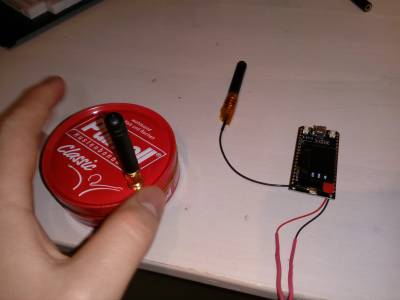sonstiges:tutorials:esp32:lora
−Inhaltsverzeichnis
LoRa - Long range network
Übersicht
Mitlerweile gibt es China LoRa module wie Sand am Meer. ESP32 LoRa Module Das Modul hat ein kleines Oled Display, LoRa und ein ESP32 onBoard. Hier ein kleiner netter Beispiel sketch für Senden und Empfangen.
Ich hafte nicht für den Code, den ich weiß zugegeben nicht ob der Sketch den EU Richtlinien entspricht. Nutzen auf eigene Gefahr! In der LoRa Lib muss auf alle Fälle die Leistung heruntergestellt werden.
Sender
- sender.cpp
// This example just provide basic LoRa function test; // Not the LoRa's farthest distance or strongest interference immunity. // For more informations, please vist www.heltec.cn or mail to support@heltec.cn #include <SPI.h> #include <LoRa.h> #include<Arduino.h> #include "SSD1306.h " // WIFI_LoRa_32 ports // GPIO5 -- SX1278's SCK // GPIO19 -- SX1278's MISO // GPIO27 -- SX1278's MOSI // GPIO18 -- SX1278's CS // GPIO14 -- SX1278's RESET // GPIO26 -- SX1278's IRQ(Interrupt Request) #define SS 18 #define RST 14 #define DI0 26 #define BAND 833E6 //915E6 -- 这里的模式选择中,检查一下是否可在中国实用915这个频段 int counter = 0; int counter2 = 0; SSD1306 display(0x3c, 4, 15); void setup() { pinMode(25,OUTPUT); //Send success, LED will bright 1 second Serial.begin(115200); while (!Serial); //If just the the basic function, must connect to a computer SPI.begin(5,19,27,18); LoRa.setPins(SS,RST,DI0); // Serial.println("LoRa Sender"); if (!LoRa.begin(BAND)) { Serial.println("Starting LoRa failed!"); while (1); } Serial.println("LoRa Initial OK!"); pinMode(16,OUTPUT); digitalWrite(16, LOW); // set GPIO16 low to reset OLED delay(50); digitalWrite(16, HIGH); // while OLED is running, must set GPIO16 in high display.init(); display.setContrast(255); } void fillRect(void) { uint8_t color = 1; for (int16_t i=0; i<DISPLAY_HEIGHT/2; i+=3) { display.setColor((color % 2 == 0) ? BLACK : WHITE); // alternate colors display.fillRect(i, i, DISPLAY_WIDTH - i*2, DISPLAY_HEIGHT - i*2); display.display(); delay(10); color++; } // Reset back to WHITE display.setColor(WHITE); } unsigned long previousMillis = 0; void loop() { int packetSize = LoRa.parsePacket(); if (packetSize) { // received a packet Serial.print("Received packet '"); display.clear(); display.setColor(WHITE); // alternate colors display.drawString(0, 0, String(counter,DEC)); display.drawString(0, 20, String(++counter2,DEC)); display.drawString(0, 40, String(LoRa.packetRssi(),DEC)); display.display(); // read packet while (LoRa.available()) { Serial.print((char)LoRa.read()); } // print RSSI of packet Serial.print("' with RSSI "); Serial.println(LoRa.packetRssi()); } unsigned long currentMillis = millis(); if (currentMillis - previousMillis >= 2000) { previousMillis = currentMillis; // send packet Serial.print("Sending packet: "); Serial.println(counter); LoRa.beginPacket(); LoRa.print("hello "); LoRa.print(counter); LoRa.endPacket(); display.clear(); display.setColor(WHITE); // alternate colors display.drawString(0, 0, String(counter++,DEC)); display.drawString(0, 20, String(counter2,DEC)); display.drawString(0, 40, String(LoRa.packetRssi(),DEC)); display.display(); } }
Empfänger
- receiver.cpp
// This example just provide basic LoRa function test; // Not the LoRa's farthest distance or strongest interference immunity. // For more informations, please vist www.heltec.cn or mail to support@heltec.cn #include <SPI.h> #include <LoRa.h> #include<Arduino.h> #include "SSD1306.h " // WIFI_LoRa_32 ports // GPIO5 -- SX1278's SCK // GPIO19 -- SX1278's MISO // GPIO27 -- SX1278's MOSI // GPIO18 -- SX1278's CS // GPIO14 -- SX1278's RESET // GPIO26 -- SX1278's IRQ(Interrupt Request) #define SS 18 #define RST 14 #define DI0 26 #define BAND 833E6 //915E6 -- 这里的模式选择中,检查一下是否可在中国实用915这个频段 int counter = 0; SSD1306 display(0x3c, 4, 15); void setup() { pinMode(25,OUTPUT); //Send success, LED will bright 1 second Serial.begin(115200); while (!Serial); //If just the the basic function, must connect to a computer SPI.begin(5,19,27,18); LoRa.setPins(SS,RST,DI0); // Serial.println("LoRa Sender"); if (!LoRa.begin(BAND)) { Serial.println("Starting LoRa failed!"); while (1); } Serial.println("LoRa Initial OK!"); pinMode(16,OUTPUT); digitalWrite(16, LOW); // set GPIO16 low to reset OLED delay(50); digitalWrite(16, HIGH); // while OLED is running, must set GPIO16 in high display.init(); display.setContrast(255); // register the receive callback //LoRa.onReceive(onReceive); // put the radio into receive mode //LoRa.receive(); } void fillRect(void) { uint8_t color = 1; for (int16_t i=0; i<DISPLAY_HEIGHT/2; i+=3) { display.setColor((color % 2 == 0) ? BLACK : WHITE); // alternate colors display.fillRect(i, i, DISPLAY_WIDTH - i*2, DISPLAY_HEIGHT - i*2); display.display(); delay(10); color++; } // Reset back to WHITE display.setColor(WHITE); } void loop() { int packetSize = LoRa.parsePacket(); if (packetSize) { // received a packet Serial.print("Received packet '"); display.clear(); display.setColor(WHITE); // alternate colors display.drawString(0, 0, String(counter++,DEC)); display.drawString(0, 20, String(LoRa.packetRssi(),DEC)); display.display(); // read packet while (LoRa.available()) { Serial.print((char)LoRa.read()); } Serial.println("Send back"); LoRa.beginPacket(); LoRa.print("ACK "); LoRa.print(counter); LoRa.endPacket(); // print RSSI of packet Serial.print("' with RSSI "); Serial.println(LoRa.packetRssi()); } }
sonstiges/tutorials/esp32/lora.txt · Zuletzt geändert: 2022-11-17 22:34 von 127.0.0.1

